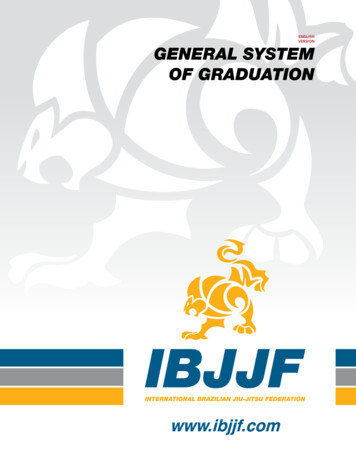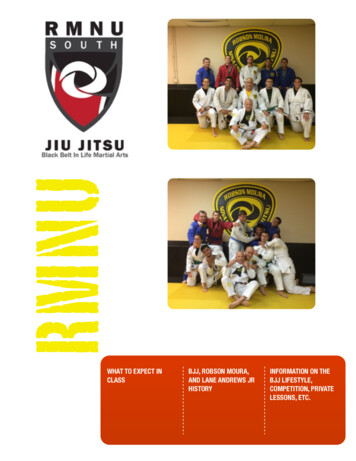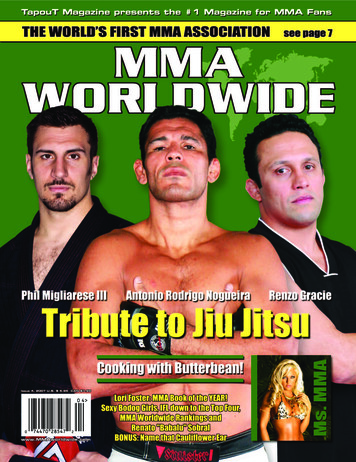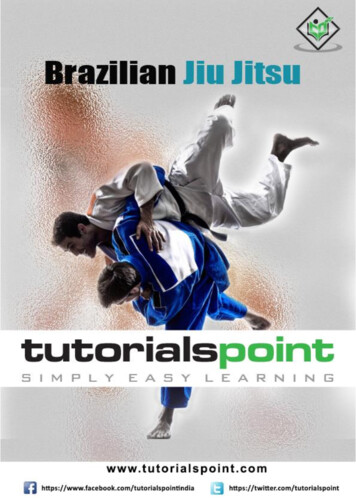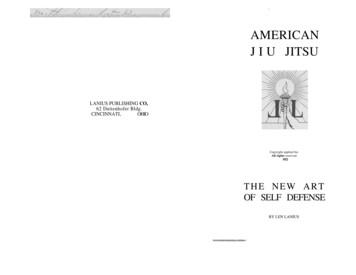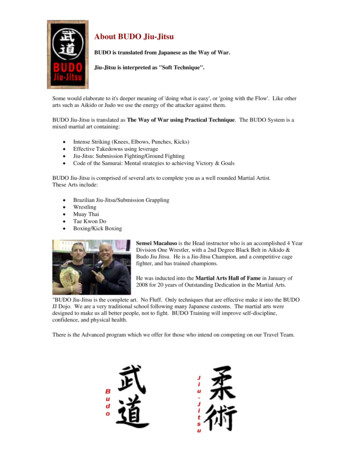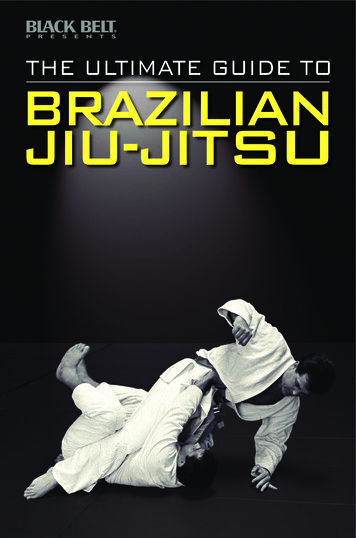
Transcription
THE ULTIMATE GUIDE TOBRAZILIANJIU-JITSU
THE ULTIMATE GUIDE TOBRAZILIANJIU-JITSU
THE ULTIMATE GUIDE TOBRAZILIANJIU-JITSUEdited by Sarah Dzida, Raymond Horwitz, Edward Pollard,Jeannine Santiago and Jon SattlerGraphic design by John BodineArchival assistance and proofreading by Monique Perdue 2008 Black Belt Communications LLCAll Rights ReservedManufactured in the United States of AmericaLibrary of Congress Control Number: 2008942249ISBN-13: 978-0-89750-297-9Electronic Edition Published 2012WarningThis book is presented only as a means of preserving a unique aspect of the heritage of the martial arts. Neither OharaPublications nor the author make any representation, warranty or guarantee that the techniques described or illustrated inthis book will be safe or effective in any self-defense situation or otherwise. You may be injured if you apply or train inthe techniques illustrated in this book and neither Ohara Publications nor the author is responsible for any such injury thatmay result. It is essential that you consult a physician regarding whether or not to attempt any technique described in thisbook. Specific self-defense responses illustrated in this book may not be justified in any particular situation in view of allof the circumstances or under applicable federal, state or local law. Neither Ohara Publications nor the author make anyrepresentation or warranty regarding the legality or appropriateness of any technique mentioned in this book.
ForewordIn terms of public awareness, the world of martial arts is a fairly insularcommunity, despite its international scope and broad influence. Outside thecircle of dedicated students and fans of some notable competitor, it probably never really amounts to much on the radar screen of public opinion.Until recently, if you asked anyone on the street to name a famous martialartist, odds are they would say Bruce Lee. Younger people have probablyheard about the tragic death of his son Brandon. And then what?The answer is: Gracie. Even if this name stirs no recognition, it rings abell. As this book is about to reveal, it is nearly impossible to consider thesubject of mixed-martial arts fighting without first hearing about a memberof the Gracie family. It could be because they are responsible for energizing and rejuvenating the practice of martial arts. It could be because wordquickly spread about the 176-pound Royce Gracie defeating much largermen in open competitions.Because the Gracie influence has become pandemic in martial arts, theirparticular discipline has come to be known as “Brazilian jiu-jitsu.”Here is the collected genesis of an emerging phenomenon as it was introduced in the pages of these magazines: Black Belt, Martial Arts Trainingand Karate/Kung Fu Illustrated. The contents have been carefully selectedand arranged to provide both a useful guide and a fascinating picture ofthe incredible success curve that has made Brazilian jiu-jitsu the disciplineand sport of a new era.Edward PollardBlack Belt Managing Editor
BLACK BELTTABLE OF CONTENTSGRACIE JIU-JITSU . 8GRACIE JIU-JITSU VS. THE WORLD . 13THE MAN WHO ACCEPTED THE GRACIE CHALLENGE. 17ROYCE GRACIE TAKES ALL COMERS IN THE UFC . 21THE BRAZILIAN JIU-JITSU INVASION. 26ROYCE GRACIE WINS UFC—AGAIN . 35HELIO GRACIE, THE FATHER OF BRAZILIAN JIU-JITSU . 40STILL KING OF THE HILL. 43ROYCE GRACIE’S CONDITIONING PROGRAM . 50TRAINING AT THE GRACIE ACADEMY . 55THE TWO-TIME UFC CHAMP IS ALL FOCUS . 58TEN REASONS WHY GRACIE JIU-JITSU WINS . 61ROYCE GRACIE SPEAKS . 64GRAPPLING IS LIKE SWIMMING . 67TOUGHEST MAN IN THE WORLD . 69IS RICKSON GRACIE THE ULTIMATE FIGHTER? . 77ROYCE ON OVERTRAINING . 81STREET JIU-JITSU VS. SPORT JIU-JITSU . 85WHO’S WHO IN GRACIE JIU-JITSU? . 88MODIFYING BRAZILIAN JIU-JITSU FOR VALE TUDO. 93IMPROVING THE IMAGE OF THE ART. 101JIU-JITSU TRAINING IN BRAZIL . 1036BJJ Book-Inside.indd 612/16/08 9:32:55 AM
THE ULTIMATE GUIDE TO BRAZILIAN JIU-JITSUULTIMATE WARRIOR. 108THE TREASURE KEEPER . 119ATTACKS AND TRAPS FROM THE GUARD . 125SURVIVAL SPORT FOR WOMEN . 129PROVING GROUND . 133GRACIES IN ACTION . 139THE HOUSE THAT GRACIE BUILT . 144GRACIE UPDATE . 149THE MAN WHO CHANGED THE WORLD . 156UP CLOSE AND PERSONAL WITH KYRA GRACIE. 1657BJJ Book-Inside.indd 712/16/08 9:33:07 AM
BLACK BELTGracie Jiu-jitsuby Don Beu Photos by Rick Hustead Black Belt August 1989Written accounts about Rorion Gracie can be misleading. Stories ofhow he tied up a roomful of Chuck Norris’ black belts, or how hechoked out kickboxer Ralph Algeria in less than three minutes, or howNavy SEALs come to him to hone their hand-to-hand combat skills cangive you a mental picture of, well, Rambo.Consequently, meeting Gracie is a bit of a jolt when you expectRambo and are instead greeted with a warm smile and handshake bya man who, at least in terms of personality and education, has more incommon with Gandhi.Easygoing and articulate, Gracie could give diplomats lessons in charmand tact. And if his friendly, personable manner runs contrary to the distant, stoic manner we’ve come to expect from many Asian masters of thefighting arts, or the tough-talking bravado often shown by many Americanfighters and competitors, that’s not unusual. This is because Gracie and hisfamily have been challenging and defeating a lot of traditions and beliefsfor more than six decades in their quest to prove the effectiveness of themartial art.And while the Gracie clan is renowned for challenging and defeatingfighters of virtually every style, behind the public victories are teachingand training methods that also challenge many traditional beliefs. Thisdeparture from tradition begins at the Gracie student’s first class. For theaverage judo or jujutsu student, as well as students of other martial arts,the bulk of the first lesson is usually devoted to learning to fall safely. Andthe student’s time with the instructor must often be shared with the rest ofthe class, usually also beginners who need the teacher’s attention.By contrast, the Gracie jiu-jitsu student’s first lesson is a private one, asare the next 35 lessons of the basic course. In that first class, the studentwill learn five simple and effective techniques: escapes from a head lock,collar grab, front choke, bear hug and one ground-fighting technique.Rather than spending at least half the class having the techniquespracticed on him, the Gracie student spends the entire class practicing thetechniques on the instructor, who provides constant feedback while thestudent perfects the moves through repetition.And what about learning to fall? The student doesn’t learn that until the36th and final basic lesson. And while this flies in the face of conventionalwisdom and may raise more than a few eyebrows among those concernedabout safety, it’s important to remember that the Gracie student is not being
THE ULTIMATE GUIDE TO BRAZILIAN JIU-JITSURorion Gracie (standing)
BLACK BELTthrown in practice. “In our system, the instructor takes the punishment,”says Rorion, who believes it’s more important that the student learn tofight effectively than to “take it.”While the average judo or jujutsu student goes home from his first classwith his hands tingling from an hour or more spent slapping the mat during falling practice, the Gracie student goes home having practiced on fivepractical and effective self-defense techniques to the point at which theyare almost a reflex. In the next class, those techniques will be reviewedand a few new ones will be shown. Every time the student comes to class,he will review the previous techniques and learn new ones. This constantrepetition is what makes the techniques become reflexive.Just as the Gracie approach to beginners departs from tradition, so doestheir approach to conditioning. No less an authority on grappling than GeneLeBell has said that being in shape is “more than half the battle” when itcomes to being an effective fighter. For most martial artists, being in shapeinvolves not just countless sit-ups, push-ups and jumping jacks but alsoplenty of running, skipping rope and frequent visits to the weight room.“We don’t like to do a lot of running,” Gracie says. “We have some specific exercises for jiu-jitsu, but these involve mostly stretching for what Ilike to call ‘combative flexibility,’ like a cat.”One reason behind this laid-back outlook on conditioning lies in theoverall philosophy of Gracie jiu-jitsu: simple techniques. A technique thatrequires a lot of skill or effort to apply is not practical against a biggeror stronger opponent, according to Gracie. “If you do it right, you don’thave to do it fast,” he says. If a martial artist takes the time to correctlyapply an effective technique, Gracie says, winning a fight will take verylittle effort.No better illustration of this can be seen than in the Gracies’ success inthe grueling arena of international-class sambo. Those familiar with thegrappling arts would agree that sambo is a tough test of a fighter’s endurance. But at the 1980 Pan American Sambo Championship, Gracie’s brotherRickson beat several more extensively trained wrestlers and judoka to winthe gold medal at 74 kilograms, while brothers Carlos and Rolls capturedthe silver and bronze medals at 80 and 68 kilograms, respectively.As for the techniques themselves, they are amazingly effective and differ quite a bit from those found in conventional judo or jujutsu. A simplestanding choke hold from the Gracie system, although similar in many waysto judo’s jui-jime (cross choke), is actually more efficient. The differencebetween jui-jime and the Gracie standing choke hold is like the differencebetween stepping on the gas of a Volkswagen and a Porsche. The Gracie10
THE ULTIMATE GUIDE TO BRAZILIAN JIU-JITSUchoke hold gets the job done a lot faster, and with a lot less effort.Another thing missing from Gracie jiu-jitsu is adherence to Orientaletiquette and traditions. For example, in Gracie jiu-jitsu, nobody bows.“That’s a part of Japanese culture,” Rorion Gracie says. “I don’t teachJapanese culture; I teach Gracie jiu-jitsu, which is from Brazil. A simplehandshake is good enough for me.”Gracie claims this departure from tradition helps new students gainself-confidence and be more comfortable. “A student doesn’t need to feelwe’re above him or anything,” Gracie says. “We’re not on top then, he feelson top. He’s at home here. We’re not gods that anybody needs to bow to;we’re just a bunch of guys from Brazil.”Rather than concentrating on the nuances of rhythm, balance and timing, the Gracies spend a lot of time practicing situations that might occurin a street fight. New or revised techniques are constantly being added tothe system. “This increases the gap between us and Japanese jujutsu, aswell as other martial arts,” Gracie says. “Gracie jiu-jitsu is for the personwho is slow, weak or thinks he’s not too intelligent. You don’t have to bestrong to do Gracie jiu-jitsu because the techniques are based on leverage.And you don’t have to be smart because we drill on the techniques untilthey become a reflex.”Rorion Gracie (top)11
BLACK BELTProof of the system’s usefulness to slower, weaker individuals can beseen in a program Gracie has initiated at several Torrance, California,schools. Gracie and school counselors target kids who are having problemsor are labeled “wimps” by their peers, and they introduce them to Graciejiu-jitsu in an effort to instill them with self-confidence and self-esteem.“After just two classes, psychologists say one of the kids is a completelydifferent person,” Gracie claims.It’s significant that the same techniques that have helped to inspire confidence and maturity in troubled youngsters are also sought out for theireffectiveness by groups with more pragmatic goals in mind, like the U.S.Navy SEALs and the Los Angeles County Sheriff’s Department. Members ofthe SEALs have asked Gracie to work out a program for them. The SEALslike his techniques “because if they
particular discipline has come to be known as “Brazilian jiu-jitsu.” Here is the collected genesis of an emerging phenomenon as it was in-troduced in the pages of these magazines: Black Belt, Martial Arts Training and Karate/Kung Fu Illustrated. The contents have been carefully selected and arranged to provide both a useful guide and a fascinating picture of the incredible success curve .
